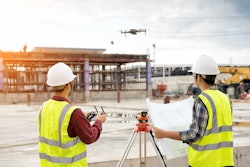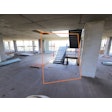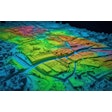
A drone with a camera is a valuable tool—an unmanned aerial vehicle—a robot that can precisely capture construction site images or point clouds on a construction site. But when combined with back-end systems that capture, convert and marry that imagery and data to a building information model (BIM) or Geographic Information System (GIS), production schedule and project plan, drones become a simple digital transformation win.
This is what Propeller Aero delivers, mostly for civil heavy, highway, excavation and site work contractors, so it is no surprise that the New South Wales, Australia company has garnered a following among both venture capital and contractors. Propeller Aero has drawn $32 million in venture capital, has swelled to about 200 employees in Australia and North America and more than 1,000 customers after being in founded just a few years back in 2014. According to company sources, the company is in the red each month due to heavy investments in research and development, but has a relatively low cash burn thanks to strong organic, recurring revenue.
While venture capital flows largely into the company’s research and development and product engineering group in Sydney, more and more marketing, customer success and sales muscle is being added in North America out of the company’s Denver location. The company takes customer success seriously, and a team of 70 is allocated across the customer base. Each customer gets a tailored onboarding program and receive further support through instructional videos, monthly webinars for platform training on the product and 24x365 support.
Users tell IronPros that Propeller Aero is perceived and priced as a Cadillac solution compared to less fully-featured applications. It is up to the Propeller Aero team to present the value that additional process automation can create in a contracting business environment.
A suite of construction drone software
From the collection of drone data to converting it to structured data to support the quote-to-cash cycle, Propeller Aero offers a front-to-back solution that makes drone imagery a central part of construction workflows. The suite encompasses several integrated products.
Propeller PPK stands for post-processed kinematic. This product automates drone image capture and processing. Users fly their site using a supported drone and AeroPoints smart ground control points to capture highly accurate, geotagged aerial images for drone mapping. Once captured, users can drag and drop flight data into Propeller PPK so it can be transformed into a 3D map of using Propeller Aero’s proprietary technology within 24 hours. This map has been reviewed by a team of GIS experts who confirm the accuracy and verify the results.
AeroPoints are high-precision, smart ground control points that provide a frame of reference for drone photogrammetry. Contractors calibrate these AeroPoints with a permanent survey mark like a slate mark and by placing the AeroPoint at that location. Or, contractors can update the AeroPoint by importing a RINEX file or data from Trimble or Topcon calibration files.
The Propeller Platform is a cloud-based drone survey visualization and analytics application that enables contractors to access the measurements and project through a realistic and geographically accurate 3D model. Contractors can assess how a project is progressing over its lifecycle using an interactive timeline slider. This 3D model has multiple other uses, and virtual walk-throughs can help contractors identify hazards and support payment and other disputes with generals or owners. Toolbox functionality enables easy calculation of quantities including stockpile volume, measurement of surface area, cut/fill and comparisons between previous surveys, design files, and sub grade models.
Crew is a Propeller Platform add-on that gives office teams the power to create and share interactive maps with professionals in the field. Each map generates a unique URL that can be shared with anyone, on any device.
Essentially, the application suite for drones is designed to capture image data from a drone and location data recorded from the AeroPoint and turn them into an accurate 3D map. The combined solution can help address survey data bottlenecks—that mean supervisors cannot make decisions, change orders cannot be defended in a timely fashion and the customer experience and profitability both suffer.
A down-to-earth new product: DirtMate
“Propeller Aero has a few products, with the core product being the drone survey product,” San Miguel said. “We are actively growing that customer base, supporting this product with product improvements and building two new products.”
One product was still under wraps at the time of the IronPros debriefings with Propeller Aero. The other, DirtMate, is survey-grade GPS receiver that does not fly on a drone but rather rests on earthmoving machines and produces elevations, measuring and capturing the elevation and using the ribbon to build a 3D model of the project with hourly and daily quantities. DirtMate does not control the blade making the cut, but does record the elevation. It is simpler and more affordable than 3D grade control technologies from Trimble, Leica or Topcon. It is non-competitive enough that it is being sold by Trimble’s SiTech dealers and can be afforded by most small contractors.
“There are a lot of telematics solutions that will give you operating data and some information on where an asset is from a broad standpoint,” Propeller Aero Co-Founder and CEO Rory San Miguel said, stressing that DirtMate will prioritize capturing and presenting data in a simple and useful way. “We are trying to get centimeter-level data off each machine. We are working hard to eliminate the data indigestion, because contractors need data that is very actionable. We are constantly iterating on how we can present the data. Earthmoving operations are usually tracking progress on a weekly basis. We think there are opportunities to automate the data capture and turn up the frequency of reporting.”
DirtMate will be a fit for smaller contractors not up for the cost or complexity of machine control that still want automated data capture to support back-office processes. Or, larger contractors that use 3D machine control on some of their equipment can update the rest with DirtMate to streamline data capture and reporting so it is on parity with the flagships in the fleet.
The DirtMate product suggests the future of Propeller Aero may be not exclusively about drones, and more about site data capture broadly. Where the company remains focused, however, is on the construction industry to the exclusion of agriculture, insurance inspections or other applications.
“Where we think the whole business is going is towards consolidating site data to make decisions and make sure it is available to everyone,” San Miguel said. “As much as we can get the information into the hands of people doing the work, we will do that. People want to empower their staff—but that is hard to do with closed systems with limited use accounts.”
Propeller Aero may rebrand at some point to reflect this broader mission, but San Miguel stressed drones would always be a huge part of the business.
A comprehensive construction drone data management product
Contractors looking at software to use with drones in a construction setting may consider desktop-based software products for processing photogrammetry. Many of these products do enable a contractor to turn those images into rich, usable and high-quality structured survey data.
“We win against competitors because we offer the same level of quality but with a hands-off approach to quality assurance,” San Miguel said. “This makes scaling up the operation a lot easier and lets them scale up their drone operation. But ultimately, drone information is needed everywhere, and it cannot just reside with the point solution user. Our cloud solution democratizes the usage of information.”
There are also other cloud-based drone surveying applications, but they cover agriculture, insurance and other industries.
Propeller Aero is in a position to add value beyond what a solution deployed in multiple industries will because it embeds drone activity and data within a construction workflow and projects. If a contractor is bidding on a job and the survey data provided by the owner is out-of-date, they can use Propeller Aero to validate or invalidate the information coming into the front of the process. During bidding, they can create calibrations to ensure they are submitting accurate numbers. As production elements of the project enter work-in-progress (WIP), Propeller Aero supports recording of progress data to drive application for payment, helping to settle disputes as there is a clear visual record to compare progress to plan.
Propeller Aero tech stack
The central data processing components of Propeller Aero reside on Amazon Web Services, but individual drone data components used in the field are engineered to operate independently of any connectivity. Data is logged on drones and other hardware and users can upload it post-capture using a wifi connection. The AeroPoint app connects to a mobile phone hotspot to load data, but that connection is not needing when the don’t need when the AeroPoint is deployed in the field. For the new Dirtmate product—Propeller Aero provides a network gateway that covers the site for wifi. But if connectivity for a machine drops out, the unit stores data and then synchs later when a connection is re-established.
The technology infrastructure that supports Propeller Aero’s drone products supported processing of 36 million photos in 2021 alone, turning them into accurate 3D maps. Part of that workload is carried by a team of experts, but high-performance compute notes on AWS and some on-premise at Propeller Aero. This enables a quality assurance process to be completed for every image, and if errors are found, there is an effort to debug the image to create a viable map. This differs from many competing products that tend to perform a specific set of automated steps to convert images, with no allowance made for managing by exception for nonconforming images or data sets.
A modern JavaScript framework on AWS enables the application to analyze rich geospatial information, produce PDF reports and cross sections. Propeller Aero uses data formats similar to those used by Trimble as the companies have an overlapping customer base. This means a Propeller Aero customer can use Trimble devices to calibrate, drag and drop data into Propeller Aero, including data out of machine control systems. Propeller Aero can also import designs created in Autodesk Civil 3D—including 3D models and GFX files.
The software integrates easily with AutoCAD and Trimble Business Center. Interoperability will increase with pending integrations with Procore, Oracle, cloud storage providers like Dropbox and Sharepoint. Propeller Aero also has projects underway with construction-specific integration platform-as-a-service (IPaaS) vendors including Agave that would open integration pathways with multiple other construction software vendors.
Hardware marketed by the company is designed in house, from the physical device to the firmware. These devices in essence log location data on internal drives and communicate it back to Propeller Aero’s AWS cloud instance for processing and to be made available to various users once connected to a network. The AeroPoint product pairs with a mobile app that uses a cell phone’s wifi hotspot and then pulls data from the AeroPoint to AWS.
Any Trimble site positioning equipment from Trimble are natively compatible with Propeller Aero.
Pricing and market
If a contractor asks how much Propeller Aero solutions cost, the best answer may be “that depends.”
The answer is based in large part on how much surveying you want to do. An operation like a small quarry that surveys its site once a month could access an annual subscription to cover that amount of usage of the data processing-heavy application, which carries the additional overhead of some human review of images. A midsized contractor that wants to survey weekly can get a 55-pack, for instance. These packages include unlimited users and an unlimited number of sites. Pricing scales all the way up to an enterprise-level all you can eat package, with the only constraint being that each of these agreements would cover a single drone for $12,000 per year.
Sometimes, a customer may buy the AeroPoints but not subscribe to the photogrammetry applications, and in these cases, they will pay a $600 annual fee for service and support of the AeroPoints. Propeller Aero resells hardware including drones at cost, and also includes in its support services updates to drone firmware using patches from the original equipment manufacturer (OEM).
This means that Propeller Aero can sell a single turnkey drone surveying solution for a fixed, predictable cost. And that means they have a broad addressable market that includes most contractors involved in sitework, excavation, heavy/highway, civil, quarries and other large, open projects. About 70 percent of their customer base of 1,300 is in the United States, with the rest split between Australia and Europe.
Contractors with more than five machines, the point at which it becomes difficult to keep track of what is going on at sites, will see value in Propeller Aero. But Propeller does well in higher volume drone surveying applications including the ENR Top 400.
BOTTOM LINE: Digital transformation in construction is about more than applying flashy tech to old problems. It is about solving problems in new ways—ways that were not possible before certain tech became ubiquitous. But digital transformation does not work if there is too much friction, as can happen when a small section of a process is addressed or automated, with returns rapidly diminishing the further from a siloed process you get. Propeller Aero understands this, and that the value is not just the drone surveying itself, but all of the non-value-added work that can be engineered out of the construction business processes up and downstream. Propeller Aero’s solutions may cost more than most competitors, and will probably be a better fit for contractors with frequent and complex surveying operations. As complexity of the operation grows, Propeller Aero can help a contractor scale through automation. Any return on investment (ROI) calculations should address the administrative and professional time by survey managers, supers, project managers and others that can be placed on higher-value, more interesting work, as well as opportunities to keep up with survey demand to support application for payment and estimating, which both generate revenue.











